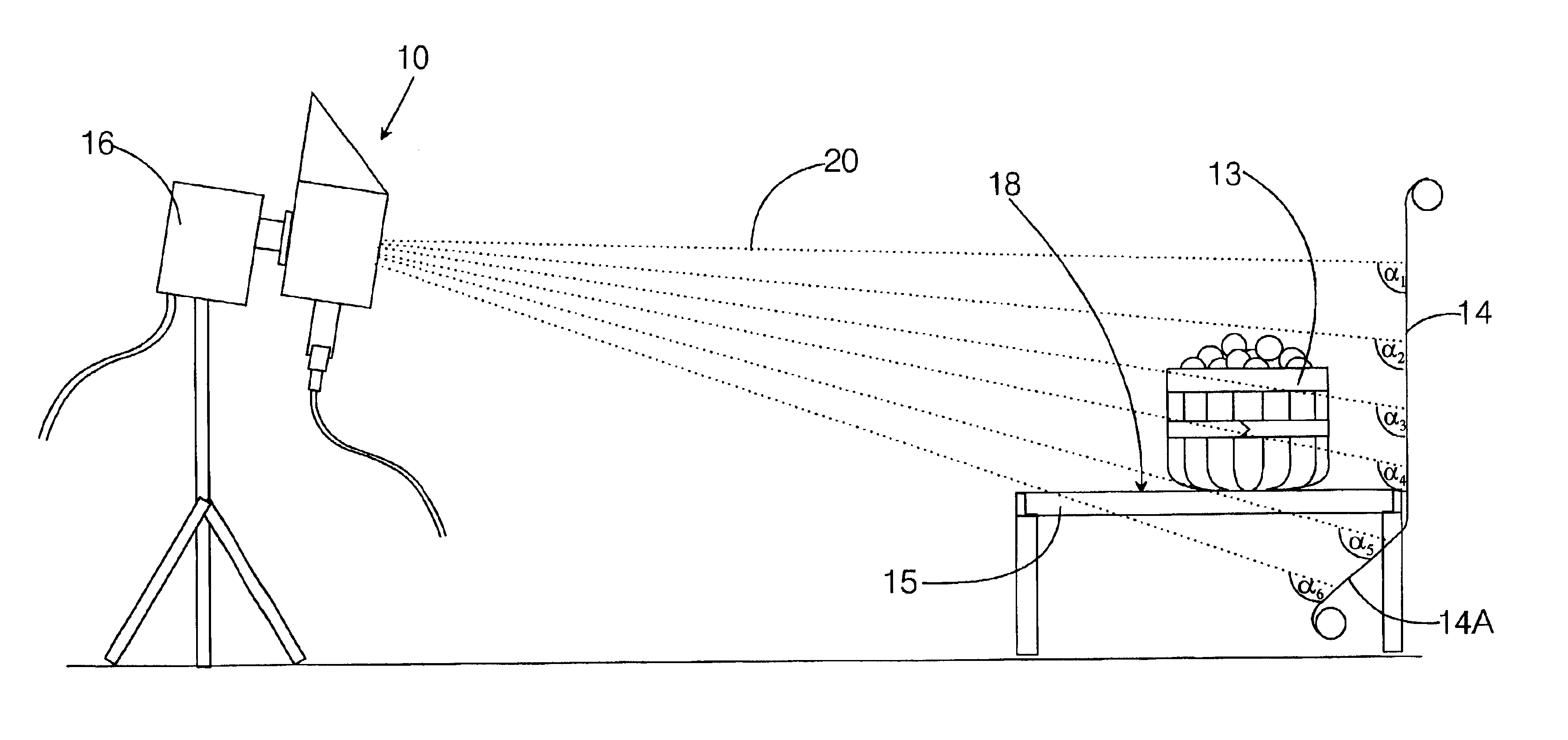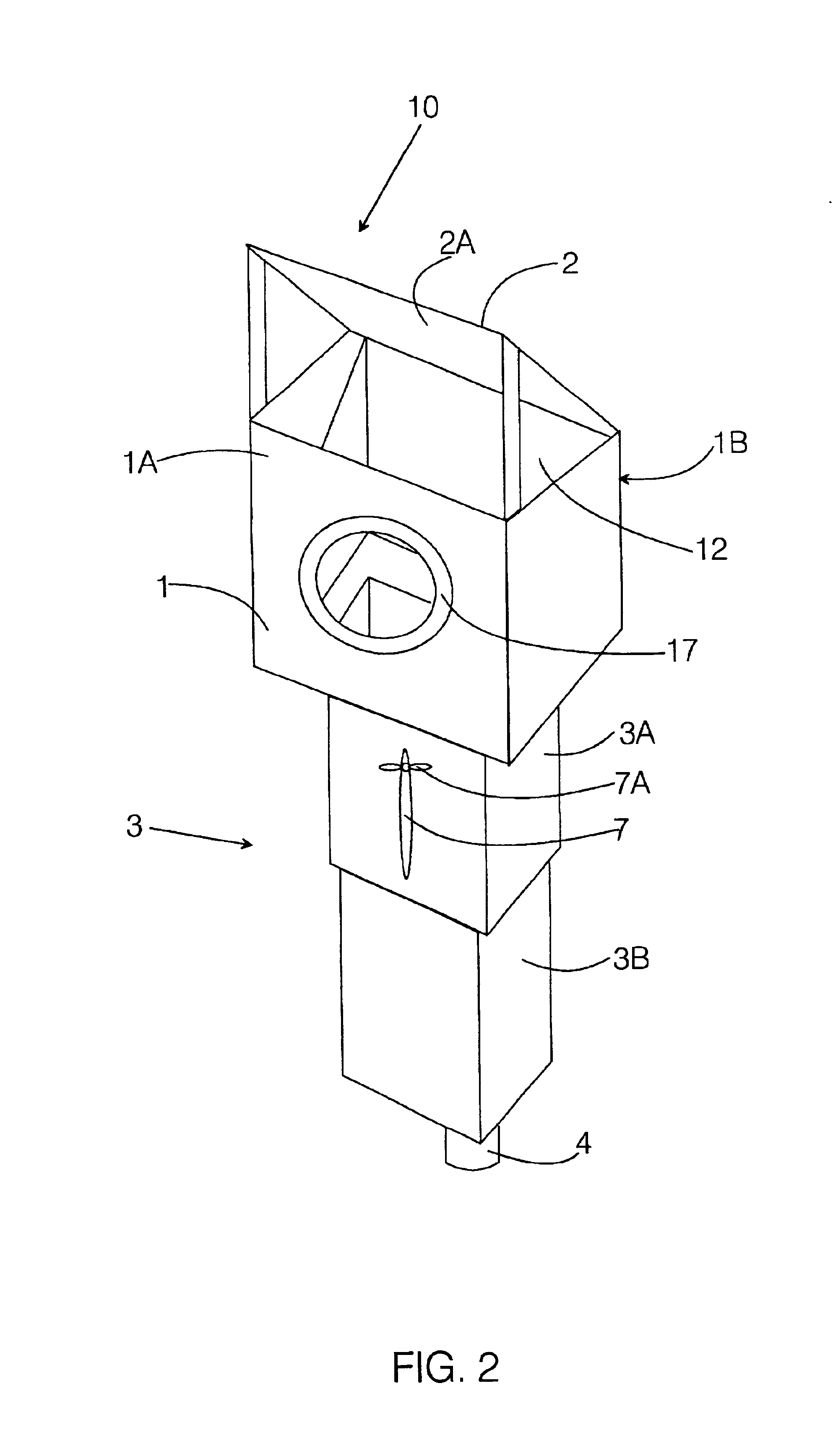[0012]For the above-cited reasons, it is an object of the present invention to provide apparatus and a method for stripping the background from a digitally photographed image that is independent of the color of the background, that is, of producing a final image that consists only of the object of interest. It is a further object to provide apparatus that is mountable on existing camera equipment and adaptable to the particular lens being used. It is a yet further object to provide such a method that involves fewer
processing operations.
[0015]Then, with the background surface as described above, and without moving the object, one takes the “
mask shot,” which is of the same scene but at a
very high level of illumination. Moreover, the illumination must “appear” to come from the direction of the
camera lens, so that the light reflected goes straight into the lens, further enhancing the contrast in
luminosity between the background and the object, as viewed by the camera.
[0016]There are a number of ways of establishing the conditions set out above for the
mask shot. One is to set up an arrangement whereby a
strobe light is triggered with the
shutter release on the camera, and the
optics arranged so that the light from the strobe is directed to the object / background as if it were emanating from the plane of the lens of the camera. The apparatus that achieves this will be denoted in this discussion as the “silhouetting apparatus.” In many embodiments of the invention, the silhouetting apparatus is set up and affixed to the
camera lens so that the principal axis of the lens is horizontal and at 90° with respect to the axis of the strong
light source used for the masking shot. In the center of this silhouetting apparatus is located a partially silvered mirror, a
light source, and a small condenser lens. The apparatus is used together with a camera and retro-reflective background sheeting to create a
mask, that is, the mask
exposure is separate, or decoupled, from the image exposures. When the camera
shutter opens, the
light source in the silhouetting apparatus causes intense light to impinge on the object to be photographed and the retro-reflective sheeting. Because of the
high reflectivity of the sheeting, the background will almost always be brighter than the object of interest. The sharp contrast that is thereby created between image and background produces a mask that provides a clean, precise outline of the image relative to the background, based on luminance. Stated in other words, the method decouples the mask
exposure from the one or more color exposures of the composite scene.
[0017]A particular
advantage of the apparatus and method of the present invention is that it is based on a background that is neutral, that is, that adds no color to the image. This offers definite
advantage when photographing transparent or
semi transparent images, such as, for example, a glass of water, because the background can be precisely defined by the difference in luminance between the glass, the water, and the background. In contrast, with the conventional method of eliminating background based on color, a photograph of a glass of water taken in front of a conventional blue sweep will result in an image of a blue glass. Assuming that the
background color discrimination is successful, the background will be eliminated, but the glass and the water will remain blue, unless, as noted earlier, the blue is close enough to the color of the pixels being stripped, in which case parts of the semi-transparent object of interest will also be stripped away.
[0020]In refining the basic technique, an aperture may be used to constrict the beam of intense light to a
beam diameter that is equal to or smaller than the
diameter of the aperture (iris) of the
camera lens. This is done to eliminate the iris shadow phenomenon that can occur when the
diameter of the projected light is greater than that of the iris and that manifests itself as a penumbra surrounding the object of interest, so that there is not a maximally sharp contrast in intensity at the border of the object and the background in the mask shot. This is referred to as a “
feathering” of the edge of the object and is definitely undesirable in the application that is the
subject matter of the present invention. In other words, restricting the
diameter of the intense
light beam used in producing the mask shot to a diameter that is coincident with or smaller than that of the camera iris improves the edge contrast around the image.
[0024]Shadows created from a misalignment of the virtual light
source image can be a source of significant shadow formation during the mask shot, shadow formation that reduces the sharpness of the background / object contrast. Thus it is important to provide a means of adjusting the silhouetting apparatus in the X and Y directions so as to be able to align the center of the virtual light source with the center of the camera lens, that is, to align the center of the virtual light source with the principal axis of the camera. Having the
virtual source off to one side will give rise to a shadow on the background on one or more sides of the object. It is also important to be able to make an adjustment in the Z direction (that is, of the
vertical distance between the real light source and the beam-splitting plate) so that the distance of the light-beam aperture from the plate is equal to the distance of the camera iris from the plate. Failure to make this adjustment can give rise to
parallax errors in the mask shot. The adjustment in the Z-direction is specific to a given lens, as each type of lens can have a different iris placement it is very important to make this adjustment before the image is produced, as
parallax errors can be very difficult to edit out of an image afterwards.
 Login to View More
Login to View More  Login to View More
Login to View More 


